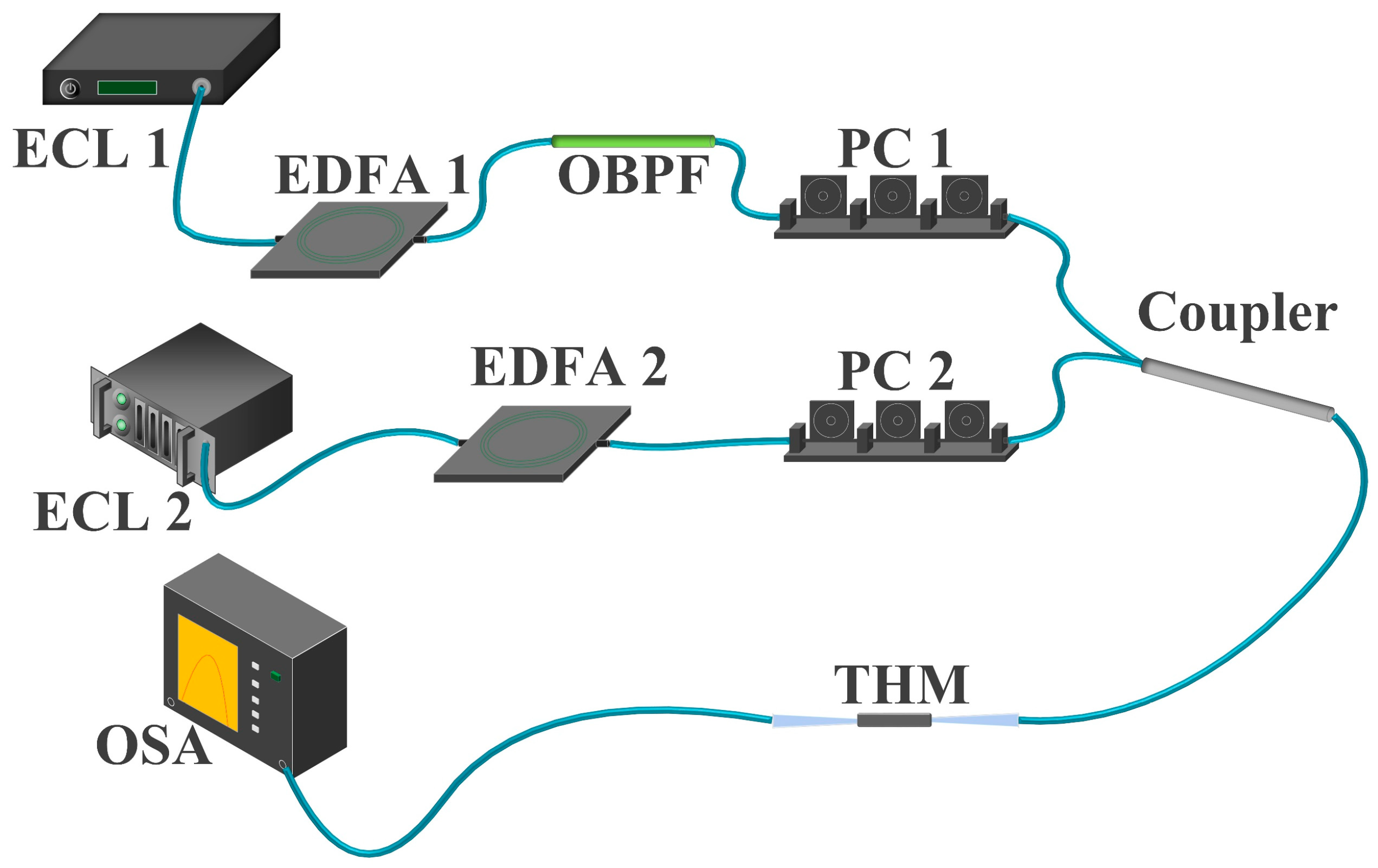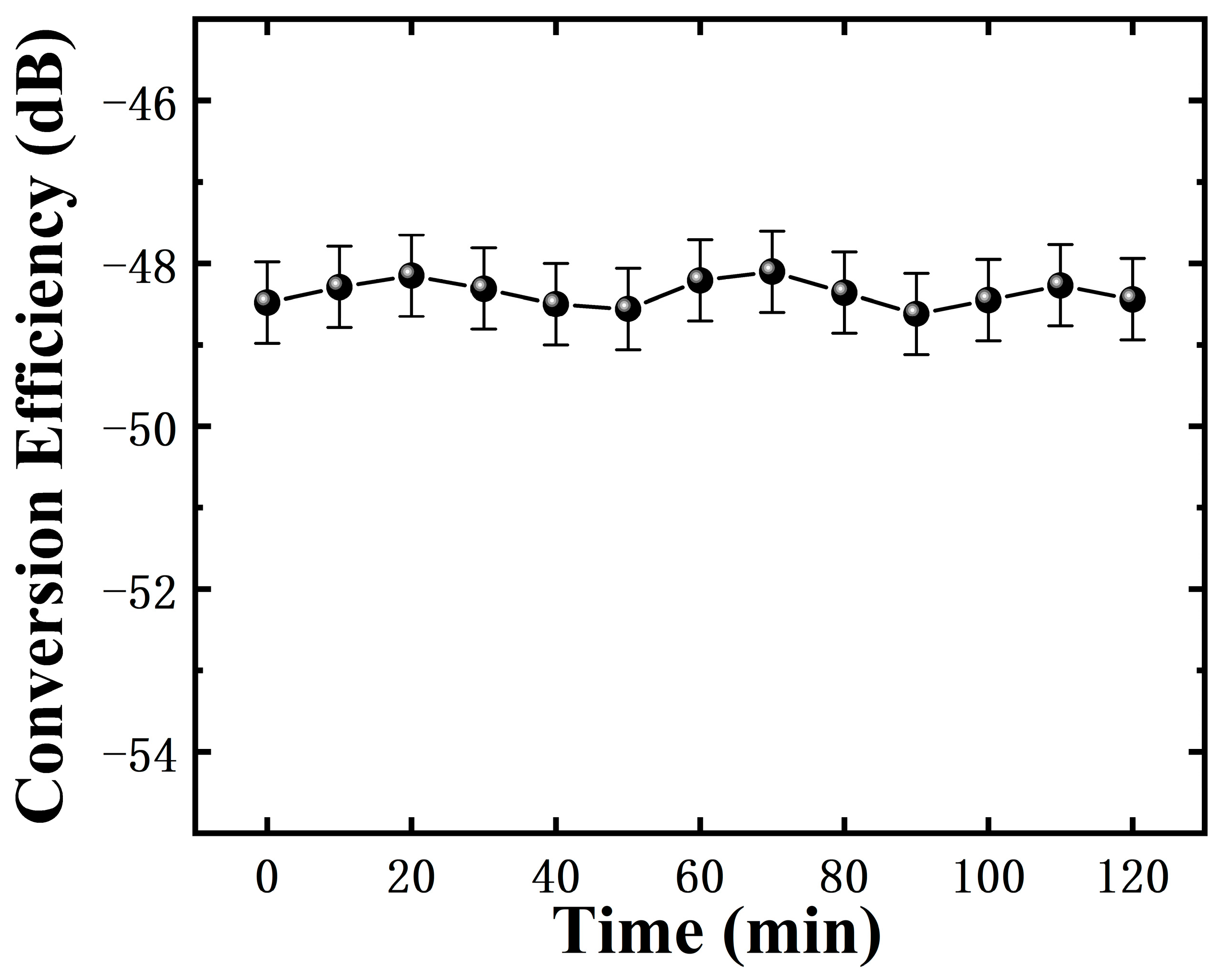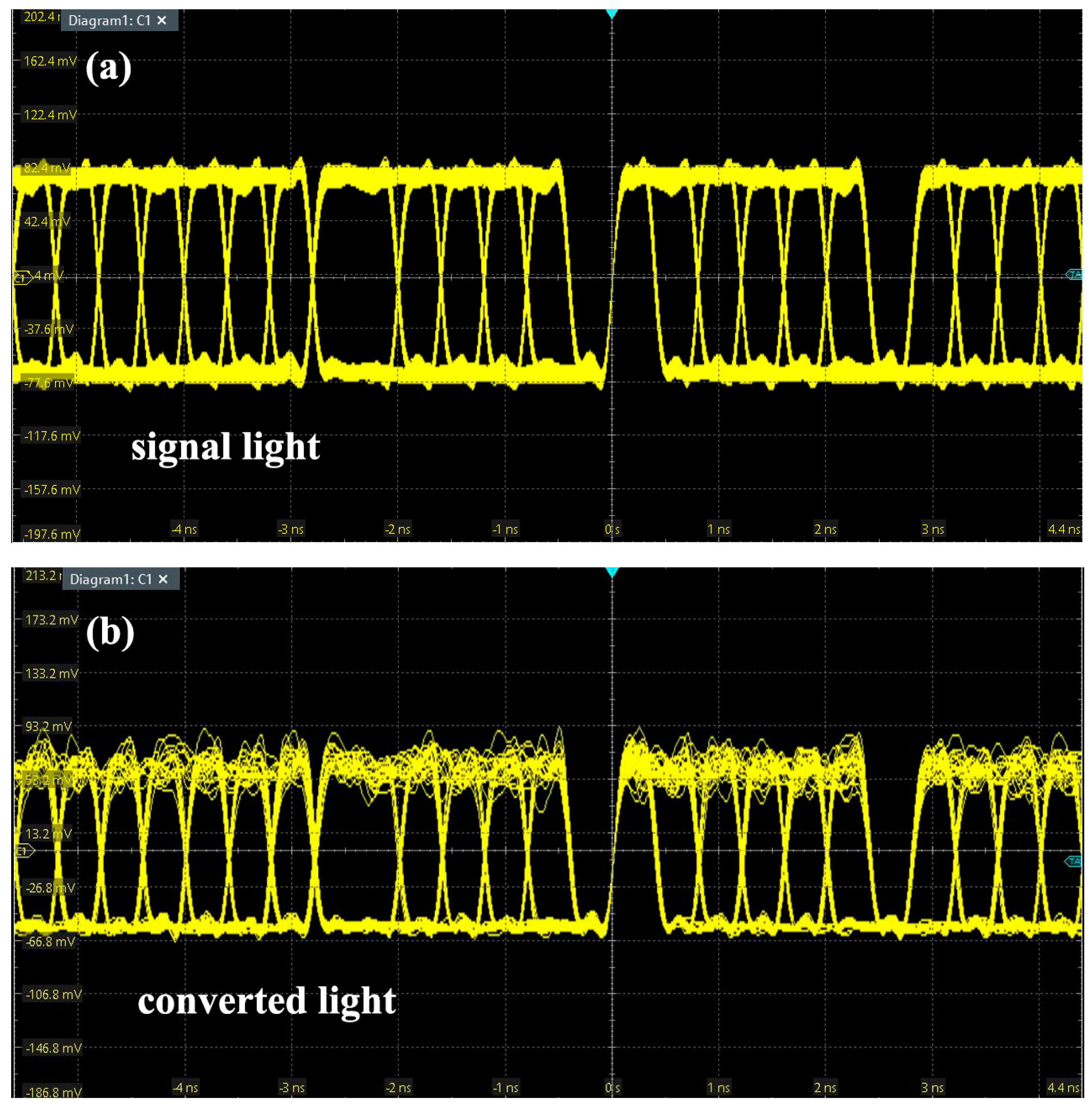TiN/Ti3C2 Heterojunction Microfiber-Enhanced Four-Wave Mixing-Based All-Optical Wavelength Converter
Abstract
:1. Introduction
2. Materials and Methods
2.1. Materials Characterization and Preparation of TiN/Ti3C2 Heterojunction-Coated Microfiber
2.2. Principle of FWM All-Optical Wavelength Converter
3. Results
3.1. THM-Enhanced FWM
3.2. All-Optical Wavelength Converter with 10 GHz Modulation Frequency
4. Conclusions
Author Contributions
Funding
Institutional Review Board Statement
Informed Consent Statement
Data Availability Statement
Conflicts of Interest
References
- Valenti, A. Experimental investigation of quality of service in an IP all-optical network adopting wavelength conversion. J. Opt. Commun. Netw. 2009, 1, 170–179. [Google Scholar] [CrossRef]
- Yang, Y.T.; Duan, M.; Lin, J.M.; Wang, Z.H.; Wang, K.; Ji, J.H.; Song, Y.F. Graphene-enhanced polarization-insensitive all-optical wavelength conversion based on four-wave mixing. Opt. Express 2022, 30, 10168–10177. [Google Scholar] [CrossRef] [PubMed]
- Wang, C.; Yang, S.; Duan, M.; Wang, Z.C.; Zhou, R.L.; Song, Y.F. Two-Dimensional Nonlinear Material MXene-Enhanced All-Optical Wavelength Converter. Acta Opt. Sin. 2021, 41, 1419001. [Google Scholar]
- Rocha, P.; Sutili, T.; Rossi, S.M.; Gallep, C.M.; Figueiredo, R.C.; Conforti, E. 32-GBd 16QAM Optical Signals Wavelength Conversion Based on Four-Wave Mixing Phenomena in Semiconductor Optical Amplifiers. In Proceedings of the 2021 SBFoton International Optics and Photonics Conference (SBFoton IOPC), Sao Carlos, Brazil, 31 May 2021–2 June 2021; pp. 1–4. [Google Scholar]
- Chow, K.K.; Shu, C.; Chinlon, L.; Bjarklev, A. Polarization-insensitive widely tunable wavelength converter based on four-wave mixing in a dispersion-flattened nonlinear photonic Crystal fiber. IEEE Photonics Technol. Lett. 2005, 17, 624–626. [Google Scholar] [CrossRef]
- Andersen, P.A.; Tokle, T.; Geng, Y.; Peucheret, C.; Jeppesen, P. Wavelength conversion of a 40-Gb/s RZ-DPSK signal using four-wave mixing in a dispersion-flattened highly nonlinear photonic crystal fiber. IEEE Photonics Technol. Lett. 2005, 17, 1908–1910. [Google Scholar] [CrossRef]
- Zhang, A.; Demokan, M.S. Broadband wavelength converter based on four-wave mixing in a highly nonlinear photonic crystal fiber. Opt. Lett. 2005, 30, 2375–2377. [Google Scholar] [CrossRef]
- Novoselov, K.S.; Geim, A.K.; Morozov, S.V. Electric Field Effect in Atomically Thin Carbon Films. Science 2004, 306, 666–669. [Google Scholar] [CrossRef]
- Wu, Y.; Yao, B.; Cheng, Y. Four-Wave Mixing in a Microfiber Attached Onto a Graphene Film. IEEE Photonics Technol. Lett. 2014, 26, 249–252. [Google Scholar] [CrossRef]
- Xu, M.S.; Liang, T.; Shi, M.M.; Chen, H.Z. Graphene-Like Two-Dimensional Materials. Chem. Rev. 2013, 113, 3766–3798. [Google Scholar] [CrossRef]
- Castro Neto, A.H.; Novoselov, K. Two dimensional crystals: Beyond graphene. Mater. Express 2011, 1, 10–17. [Google Scholar] [CrossRef]
- Mas-Balleste, R.; Gomez-Navarro, C.; Gomez-Herrero, J.; Zamora, F. 2D materials: To graphene and beyond. Nanoscale 2011, 3, 20–30. [Google Scholar] [CrossRef]
- Ataca, C.; Sahin, H.; Ciraci, S. Stable, Single-Layer MX2 Transition-Metal Oxides and Dichalcogenides in a Honeycomb-Like Structure. J. Phys. Chem. C 2012, 116, 8983–8999. [Google Scholar] [CrossRef]
- Zhang, H.; Liu, C.; Qi, X.; Dai, X.; Fang, Z.; Zhang, S. Topological insulators in Bi2Se3, Bi2Te3 and Sb2Te3 with a single Dirac cone on the surface. Nat. Phys. 2009, 5, 438–442. [Google Scholar] [CrossRef]
- Mak, K.F.; Lee, C.; Hone, J.; Shan, J.; Heinz, T.F. Atomically thin MoS2: A new direct-gap semiconductor. Phys. Rev. Lett. 2010, 105, 136805. [Google Scholar] [CrossRef]
- Wang, Q.H.; Kalantar-Zadeh, K.; Kis, A.; Coleman, J.N.; Strano, M.S. Electronics and optoelectronics of two-dimensional transition metal dichalcogenides. Nat. Nanotechnol. 2012, 7, 699–712. [Google Scholar] [CrossRef]
- Zuo, Y.; Yu, W.; Liu, C. Optical fibres with embedded two-dimensional materials for ultrahigh nonlinearity. Nat. Nanotechnol. 2020, 15, 987–991. [Google Scholar] [CrossRef] [PubMed]
- Li, Y.; Rao, Y.; Mak, K.F. Probing symmetry properties of few-layer MoS2 and h-BN by optical second-harmonic generation. Nano Lett. 2013, 13, 3329–3333. [Google Scholar] [CrossRef] [PubMed]
- Liu, X.; Guo, Q.; Qiu, J. Emerging Low-Dimensional Materials for Nonlinear Optics and Ultrafast Photonics. Adv. Mater. 2017, 29, 1605886. [Google Scholar] [CrossRef]
- Chen, S.; Miao, L.; Chen, X.; Chen, Y.; Zhao, C.; Datta, S.; Li, Y.; Bao, Q.; Zhang, H.; Liu, Y.; et al. Few-Layer Topological Insulator for All-Optical Signal Processing Using the Nonlinear Kerr Effect. Adv. Opt. Mater. 2015, 3, 1769–1778. [Google Scholar] [CrossRef]
- Zheng, J.L.; Yang, Z.H.; Si, C.; Liang, Z.M.; Chen, X.; Cao, R.; Guo, Z.N.; Wang, K.; Zhang, Y.; Ji, J.H.; et al. Black Phosphorus Based All-Optical-Signal-Processing: Toward High Performances and Enhanced Stability. ACS Photonics 2017, 4, 1466–1476. [Google Scholar] [CrossRef]
- Wang, K.; Chen, Y.X.; Zheng, J.L.; Ge, Y.Q.; Ji, J.H.; Song, Y.F.; Zhang, H. Black phosphorus quantum dot based all-optical signal processing: Ultrafast optical switching and wavelength converting. Nanotechnology 2019, 30, 415202. [Google Scholar] [CrossRef] [PubMed]
- Island, J.O.; Steele, G.A.; van der Zant, H.S.J.; Castellanos-Gomez, A. Environmental instability of few-layer black phosphorus. 2D Mater. 2015, 2, 011002. [Google Scholar] [CrossRef]
- Shao, P.Z.; Zhao, H.M.; Cao, H.W.; Wang, X.F.; Pang, Y.; Li, Y.X.; Ren, T.L. Enhancement of carrier mobility in MoS2 field effect transistors by a SiO2 protective layer. Appl. Phys. Lett. 2016, 108, 203105. [Google Scholar] [CrossRef]
- Xia, F.; Farmer, D.B.; Lin, Y.M.; Avouris, P. Graphene field-effect transistors with high on/off current ratio and large transport band gap at room temperature. Nano Lett. 2010, 10, 715–718. [Google Scholar] [CrossRef]
- Wang, K.; Liu, Q.D.; Wang, Z.H.; Song, Y.F.; Huang, H.M.; Fan, N.; Wang, Y.J.; Zhang, B. TiN/ Ti3C2 heterojunction-based photonic device for optical Kerr switch. RSC Adv. 2023, 13, 24649. [Google Scholar] [CrossRef]










| Baud | 1.25G | 2.5G | 5G | 6G | 8G |
|---|---|---|---|---|---|
| BER | 3.3 × 10−4 | 3 × 10−4 | 2.8 × 10−4 | 2.7 × 10−4 | 2.1 × 10−4 |
Disclaimer/Publisher’s Note: The statements, opinions and data contained in all publications are solely those of the individual author(s) and contributor(s) and not of MDPI and/or the editor(s). MDPI and/or the editor(s) disclaim responsibility for any injury to people or property resulting from any ideas, methods, instructions or products referred to in the content. |
© 2023 by the authors. Licensee MDPI, Basel, Switzerland. This article is an open access article distributed under the terms and conditions of the Creative Commons Attribution (CC BY) license (https://creativecommons.org/licenses/by/4.0/).
Share and Cite
Wang, K.; Liu, Q.-D.; Song, Y.-F.; Zhang, B.; Zeng, Q.-D.; Zhang, Y.-Y.; Wang, Z.-H. TiN/Ti3C2 Heterojunction Microfiber-Enhanced Four-Wave Mixing-Based All-Optical Wavelength Converter. Photonics 2023, 10, 1066. https://doi.org/10.3390/photonics10101066
Wang K, Liu Q-D, Song Y-F, Zhang B, Zeng Q-D, Zhang Y-Y, Wang Z-H. TiN/Ti3C2 Heterojunction Microfiber-Enhanced Four-Wave Mixing-Based All-Optical Wavelength Converter. Photonics. 2023; 10(10):1066. https://doi.org/10.3390/photonics10101066
Chicago/Turabian StyleWang, Ke, Qi-Dong Liu, Yu-Feng Song, Bin Zhang, Qing-Dong Zeng, Yuan-Yuan Zhang, and Zhen-Hong Wang. 2023. "TiN/Ti3C2 Heterojunction Microfiber-Enhanced Four-Wave Mixing-Based All-Optical Wavelength Converter" Photonics 10, no. 10: 1066. https://doi.org/10.3390/photonics10101066
APA StyleWang, K., Liu, Q.-D., Song, Y.-F., Zhang, B., Zeng, Q.-D., Zhang, Y.-Y., & Wang, Z.-H. (2023). TiN/Ti3C2 Heterojunction Microfiber-Enhanced Four-Wave Mixing-Based All-Optical Wavelength Converter. Photonics, 10(10), 1066. https://doi.org/10.3390/photonics10101066






